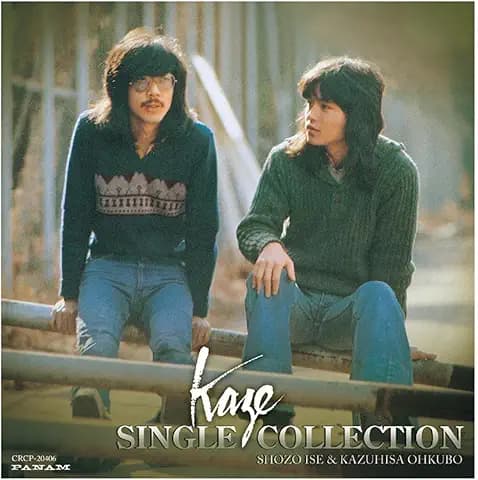曲の紹介「22才の別れ」

- 曲名:22才の別れ
- アーテイスト::かぐや姫/風
- 作詞・作曲:伊勢正三
- レーベル:PANAM(日本クラウン)
- サマリー:
- 1974年3月5日かぐや姫の4枚目のアルバム「三階建の詩(さんかいだてのうた)」に収録された。
- かぐや姫解散後に、伊勢正三が大久保一久と結成したフォークデュオ「風」のデビューシングルとして1975年2月5日リリースされた。
- オリコンチャートでは70.8万枚を売り上げ、大ヒットした。
- 記事引用元:
- 22才の別れ-Wikipedia
- 風-Wikipedia
- かぐや姫-Wikipedia
- 伊勢正三
曲と歌詞について
「22才の別れ」は、22才になった女性が、恋人に別れを告げる日の心の言葉を綴っています。
5年間付き合ってきて、気持ちは変わらずにいるけれども、おそらく彼との交際は結婚へのゴールが見えないのでしょう。
理由は分かりませんが、もしかしたら彼は夢を追っているのかもしれません。
彼女も22才になり、恋よりも将来の安定を選んだため、彼と別れる決心をしました。
そして今、「さようなら」を言おうとしている。
誰の青春時代にもありそうな経験を描写おり、リスナーの若い頃の記憶を蘇らせ、胸を熱くさせます。
ほんとうに、青春の1コマをみごとに切り取り、切なく表現している名曲だと思います。
曲の動画
- 風(Kaze) – 22才の別れ (Official Audio)
- 【LIVE】2020.11.8 ISE SHOZO LIVE 2020〜Re-born〜
アーティストの紹介
かぐや姫
- アーティスト:かぐや姫(第2期「南こうせつとかぐや姫」)
- メンバー:
- 南こうせつ(ボーカル&ギター)
- 伊勢正三(ボーカル&ギター)
- 山田パンダ(ボーカル&ベース)
- 活動場所:日本
- 活動時期:1971年-1975年
- 公式サイト:日本クラウン紹介ページ
アーティストの軌跡
1971年9月シングル「青春」で再デビュー(第1期は1970年にデビュー)し、1972年3月テレビアニメ主題歌「海のトリトン」を須藤リカ/南こうせつとかぐや姫でシングルリリースしました。
1973年9月シングル「神田川」をリリースし、最終的に160万枚を売り上げ、大ヒットとなりました。
その年のNHK紅白歌合戦の出場依頼が来ましたが、歌詞に出てくるクレパスが製品名であり、クレヨンへの変更を求められて出場を辞退しています。
1975年4月12日東京神田共立講堂で解散コンサートを最後に解散しました。
その後、南こうせつと山田パンダはソロとして、伊勢正三は風を結成し音楽活動を続けています。
風
- アーティスト:風
- メンバー:
- 伊勢正三(ボーカル&ギター)
- 大久保一久(ボーカル&ギター)
- 活動場所:日本
- 活動時期:1975年-1979年
- 公式サイト:日本クラウン紹介ページ
アーティストの軌跡
伊勢正三と、猫(フォークグループ)の大久保一久が結成しました。
1975年にリリースしたシングル「22才の別れ」は、オリコンで第1位となる大ヒットを記録しました。
他の代表曲は、「海岸通」「あの唄はもう唄わないのですか」「ささやかなこの人生」「君と歩いた青春」などがあります。
1979年に活動は休止しましたが、1990年8月の第10回サマーピクニックで共演をしています。
伊勢正三
- アーティスト:伊勢正三
- 誕生日:1951年11月13日
- 出身地:日本大分県津久見市
- 活動時期:1970年-
- 公式サイト:ISE SHOZO OFFICIAL SITE
アーティストの軌跡
大分県の高校で伊勢正三の音楽部の先輩として活動していた南こうせつは、東京で「かぐや姫」を結成しました。その後、大学に進学した伊勢正三を誘い、山田パンダも加わる形で「かぐや姫」が再び結成されました。
伊勢正三の「22才の別れ」は、かぐや姫のアルバム「三階建の詩」に収録されるために作られた2曲のうちの1つです。(もう1曲は「なごり雪」です。)
シングルとしてのリリースを望む声もありましたが、最終的には「かぐや姫」としては発売されず、後に「風」というグループ名でシングルとして発表されました。
なお、「風ファーストアルバム」にはこの曲は含まれていません。この曲は「かぐや姫」時代の作品であったため、アルバムには収録されなかったようです。
青春を共に過ごした世代にとって、「22才の別れ」はまさに青春そのものを象徴する楽曲ではないでしょうか。アコースティック・ギターのイントロを聞くだけで、涙があふれてくるのは私だけでしょうか?